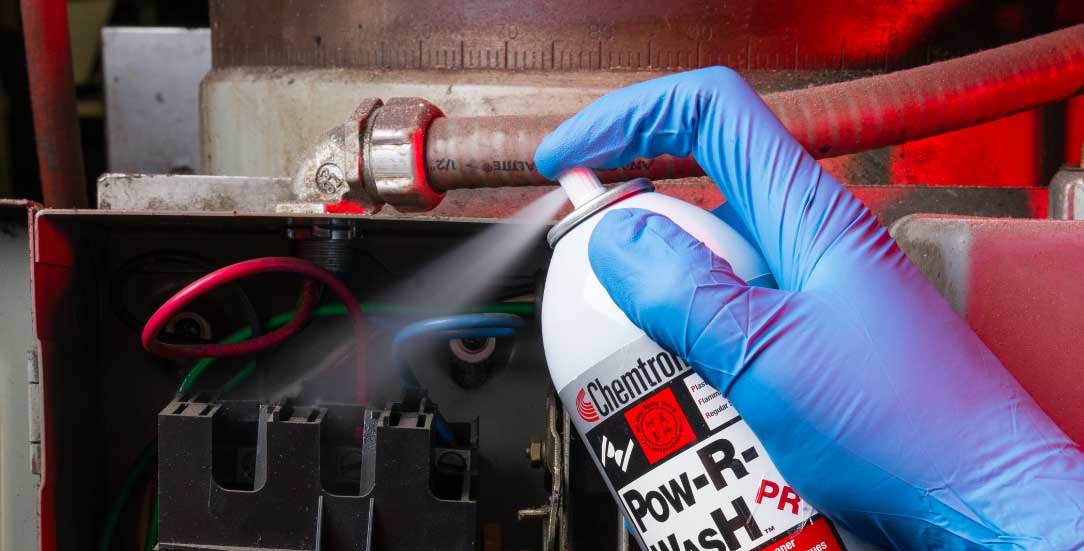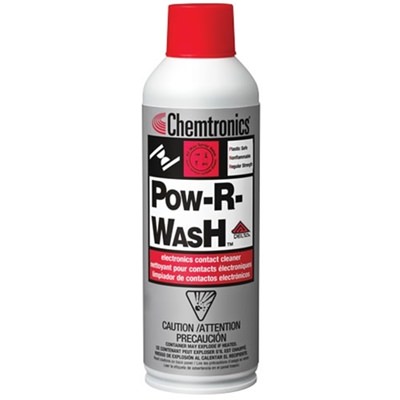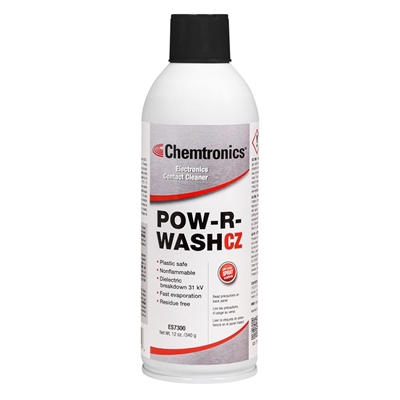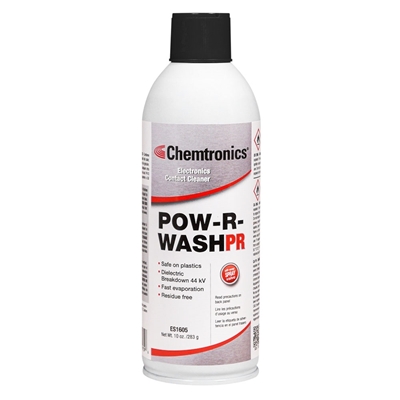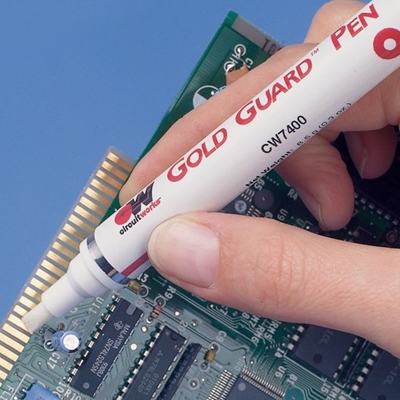You're getting intermittent issues with your device, so you suspect there's contamination in the electrical contacts. Dust, dirt, grease, and oxidation contamination can increase electrical resistance in contact areas. That means the current flow is potentially reduced or interrupted, affecting the performance of the device and potentially leading to safety hazards.
It’s time to pull out your trusty can of electrical contact cleaner. What follows is everything you need to know in selecting a contact cleaner.
Index of Topics
- What is a contact cleaner?
- How do I prevent oxidation / rust?
- How do I improve electrical continuity?
- Should a contact cleaner be nonflammable?
- What does “high flash” or “flash point” mean?
- Do I need to shut off power before cleaning contacts?
- Is it safe clean electrical contacts while the power is on?
- Are there cleaners that are safe on plastic connectors?
- Are there environmental concerns with using electrical contact cleaners?
- Chemtronics Pow-R-Wash™ Contact Cleaners
What is a contact cleaner?
A contact cleaner (also called electrical cleaner, switch cleaner, electrical contact cleaner, and, specific to automotive repair, battery terminal cleaner) is a solvent cleaner designed to remove contamination from electrical contacts, the conductive surfaces of connectors, switches and other electrical and electronic components with moving surface contacts.
The goal is to quickly remove insulative contamination as quickly as possible, avoiding a lot of wiping and scrubbing if possible. Contact cleaning solvents usually come in pressurized aerosol packaging for convenience and to provide a forceful spray that creates agitation and reaches into all the crevices of the connectors.
Chemtronics offers a large selection of aerosol electrical contact cleaners under the Pow-R-Wash™ brand, which range from economical heavy-industry cleaners to high precision solvents for sensitive components.
Why do I need an electrical contact cleaner?
Dust, dirt, grease, and oxidation contamination can increase electrical resistance in contact areas. That means the current flow is potentially reduced or interrupted, affecting the performance of the device and potentially leading to safety hazards (i.e. areas with high resistance can start to heat up, or conductive contamination can create a short).
Any contamination in the contact area compounds the connectivity challenges already present from the resistivity of any surface oxidation and the limited contact area.
How do I remove oxidation / rust?
To improve the connection quality of an electrical contact or switch, you can remove oxidation or rust either mechanically and/or chemically. A brass or steel brush is the most common method of scrubbing off oxidation, although for sensitive contacts nylon is often used. Regardless, take care to avoid damaging contacts and other components.
It can be difficult to directly clean all the tight areas of electrical connectors and switches, so you may need to use a chemical. On the mild side, an acid like vinegar can be used, and other agents may work for battery terminal cleaning, such as baking soda. Regardless of the cleaning material, it must be rinsed off. A cleaner strong enough to remove rust could continue to work on unintended metal surfaces.
How do I prevent oxidation / rust?
There are contact cleaners available with an oil additive, which provides a thin layer of protection from rust-causing oxygen and moisture. Chemtronics DPL (Deep Penetrating Lubricant) can be used to remove existing moisture and prevent oxidation.
CircuitWorks® Gold Guard™ Pen is engineered to clean, lubricate and protect gold, silver, platinum and other precious metal contacts. It is a high performance contact cleaner and lubricant dispensed by a convenient marker pen delivery system. The Gold Guard lubricant offers protection from oxidation and corrosion while improving contact and conductivity.
CircuitWorks® Silver Conductive Grease can be used to provide an electrically conductive barrier that protects from moisture, oxidation, and other environmental hazards, while maximizing electrical conductivity through the contacts. This electrically conductive grease utilizes an advanced silicone lubricant that is compatible with metal, rubber, and plastic. Use it to fill connector gaps, provide grounding for circuits, and control static discharge.
How do I improve electrical continuity?
CircuitWorks® Silver Conductive Grease can be used to provide an electrically conductive barrier that protects from moisture, oxidation, and other environmental hazards. This electrically conductive grease utilizes an advanced silicone lubricant that is compatible with metal, rubber, and plastic. Use it to fill connector gaps, provide grounding for circuits, and to control static discharge.
What do I look for when selecting a contact cleaner?
Like when selecting any other product, there are options and trade-offs to consider. It’s tempting to jump right to the lowest-priced product, but there are a number of other factors that can have a big impact on performance and safety:
- Flammability – Many commercially available contact cleaners contain alcohols and hydrocarbon solvents which are very flammable. They are economical and generally effective cleaners, but can pose a safety hazard without proper ventilation, and if there are open flames, sparks (e.g. welding process), or hot surfaces nearby. Nonflammable contact cleaners are available to avoid these safety issues, but may be offered at a premium price. Some nonflammable cleaners also have significant toxicity concerns, and may contain toxic materials such as Perchloroethylene, trichloroethylene or n-propyl bromide. High flashpoint (often called “high flash”) solvents are still flammable, but the vapors are less likely to combust in normal ambient temperatures (say below 140°F/60°C).
- Dielectric strength – If you plan to clean contacts with the power on, or may turn it on before the solvent has fully evaporated, you should look for a cleaner with as high of dielectric strength as possible. Always know the amperage and voltage of the circuits you are trying to clean before spraying anything onto the circuits, and evaluate the suitability of any cleaner in your application. Dielectric strength is defined as the maximum electric field that the material can withstand before its insulating properties break down. In other words, the lower the dielectric strength, the more likely it will break down and allow electricity to flow through it, creating a short circuit and/or a significant safety issue.
- Plastic / rubber compatibility – While the contact surfaces of connectors are metal, they are often housed in plastic, along with rubber gaskets as seals. If the solvent used in a contact cleaner is incompatible with the plastic, it can craze (create small cracks), embrittle, or soften the material. Rubber seals may swell, shrink or even dissolve if exposed to a harsh solvent. A new contact cleaner should always be tested before being used extensively on your new (and expensive) equipment.
- Toxicity – N-Propyl Bromide (nPB), Trichloroethylene (TCE) and Perchloroethylene (Perc) are toxic chemicals commonly used in contact cleaners to provide cleaning performance in a nonflammable formula. Workers have suffered major health effects when exposed to high levels of these chemicals. They reported headaches, dizziness, and even loss of full body control. Further studies have shown a possible link to reproductive problems and cancer. These risks have prompted maintenance facilities to rethink their solvent choices, especially with manual cleaning when exposure tends to be higher than the more automated cleaning processes. No Chemtronics Pow-R-Wash™ contact cleaners contain any of these highly toxic solvents.
- Environmental issues – In the past, ozone depletion was a concern with contact cleaners containing chlorofluorocarbons (CFCs) like the Freon of old and hydrochlorofluorocarbons (HCFCs) like AK-225. Since those solvents are no longer available on the commercial market in North America, concerns have turned to volatile organic compounds (VOCs), solvents that add to smog, or solvents with high global warming potential (GWP). Some state (e.g. CARB, then California Air Review Board), municipal, and even industry-specific regulations restrict the use of high VOC or high GWP materials.
More detailed explanations of each topic are below.
Should a contact cleaner be nonflammable?
While it isn’t always necessary, a nonflammable contact cleaner would be the safest option if the vapors or liquid could be exposed to sparks, open flames, or hot surfaces. Of course, when the electrical device is powered, there is a much greater potential for sparks.
Many commercially available contact cleaners contain alcohols and hydrocarbon solvents which are very flammable. They are economical and effective cleaners but can pose a safety hazard without proper ventilation, or if there are open flames, sparks (e.g. welding process), or hot surfaces nearby. Nonflammable contact cleaners are available to avoid these safety issues.
Nonflammable electrical contact cleaners are readily available, although they are generally more expensive than flammable contact cleaners. Chemtronics had several nonflammable contact cleaners available, including Pow-R-Wash™ VZ , Pow-R-Wash CZ, Pow-R-Wash Delta, and Pow-R-Wash PR.

The most common method of identifying the flammability rating of an aerosol contact cleaner is the GHS (Global Harmonized System) flammable pictogram (see diamond symbol above). Unless an aerosol contact cleaner is able to pass a very stringent test, it must have the flammable pictogram on the label. In a nutshell, the test involves spraying the solvent cleaner into a drum with a candle for 5 minutes. If it doesn’t ignite within that time period, the cleaner is considered nonflammable.
Other standards, like NFPA (National Fire Protection Association) and HMIS (Hazardous Materials Identification System), provide a rating from 0 to 4, zero being the lowest flammability rating, or nonflammable. These ratings are derived from a version of a flash point test. To measure the flash point of a solvent, it is heated from room temperature to boiling point, all the while trying to light the vapors with either a sparker or lighter of some sort. If the vapors light, the temperature of the heated solvent is recorded at the time, providing a flash point.
What does “high flash” or “flash point” mean?
You may find some contact cleaners and other industrial cleaners with “High Flash” or “HF” in the name. High flashpoint solvents still support combustion but the vapors will not combust in normal ambient temperatures (say below 140°F/60°C). This rating is derived from a version of a flash point test. To measure the flash point of a solvent, it is heated from room temperature to boiling point, all the while trying to light the vapors with either a sparker or ignition source. If the vapors light, the temperature of the heated solvent is recorded at the time providing a flash point.
High flash point contact cleaners are generally chosen because they have a relatively low cost and considered safer to use in normal operating conditions compared to highly flammable solvents. Be aware that high flash cleaners commonly contain terpene-based solvents and/or citrus-based d-limonene solvents, which have extremely slow evaporation. While an alcohol-based solvent might fully evaporate out of a connector in minutes, a high flash solvent could take hours.
Do I need to shut off power before cleaning contacts?
BEFORE you start spraying, we strongly recommend you shut down power to avoid the potential of sparks, electrical shorts or discharges, and other safety hazards. If, for whatever reason, you don’t have the option of disconnecting the power, look for electrical contact cleaners with a dielectric strength above 30 kV (30,000 volts). Choosing a nonflammable cleaner would also add a layer of safety in case there is a spark.
Is it safe to clean electrical contacts while the power is on?
There is no way to give a definite answer for all circumstances, because safety is highly dependent on the voltage and amperage as well as environmental factors such as the equipment or working environment. On the other hand, choosing a contact cleaner with high dielectric strength or breakdown (also called withstand) voltage are safer choices when you do have to clean energized equipment. A nonflammable cleaner would also add a layer of safety in case there is a spark.
What is dielectric strength?
Dielectric strength is defined as the maximum electric field that the material can withstand under ideal conditions without breaking down. Breaking down in this sense is described as a failure of insulating properties, where the electricity breaks free of the conductors and burns a path through the weakest area of the insulating materials.
And it’s not a breakdown over time. As soon as there is enough free electricity it will immediately or, in a nanosecond, discharge through the insulating material. If it doesn’t discharge through, it’s going to severely degrade it to the point it is of no insulating use.
So if you’ll be working on powered equipment, you’ll want a cleaner with high dielectric strength. Remember, certain soils such as carbon are effective conductors of electricity, and both the combination of the conductivity of the soil and cleaning solution need to be taken into consideration. You want the cleaner to act as an insulator to protect you while you are using it. It seems basic, but it should clean an energized surface, not conduct electricity back to you or to your insulating material and it should not corrupt or attack the circuit you are cleaning. When selecting a contact cleaner, look for dielectric strength in the product specifications. The higher the number the better, and you want to avoid spraying energized contacts with anything below 30 kV (30,000 volts).
Should I worry about plastic connectors and components and rubber seals when contact cleaning?
While the contact surfaces of connectors are metal, they are often housed in plastic, with rubber gaskets to seal everything from the outside environment. If the solvent used in a contact cleaner is incompatible with the plastic, it can craze (create small cracks), embrittle, or soften the material. Rubber seals may swell, shrink or even dissolve if exposed to a harsh solvent.
Rigid plastics like ABS, polycarbonate (trade name Lexan), and acrylic materials like Plexiglass can be very sensitive to harsh solvents like toluene, xylene, and acetone. Alcohol and hydrocarbon-based solvents tend to be better on sensitive plastics.
Rubber, silicone or other seals or gaskets made of elastomeric (soft) materials can swell or shrink with exposure to harsh solvents. After the solvent flashes off, they may spring back to their original dimensions, or be permanently changed, impacting the effectiveness of the seal. Polyester or Teflon-based gasketing materials are less prone to this type of damage from harsh solvents.
A new contact cleaner should always be tested before use on any questionable applications, or those using any live (and expensive) equipment. If you do have very sensitive materials to clean, Chemtronics offers Pow-R-Wash CZ for the best material compatibility.
Are there cleaners that are safe on plastic connectors?
Alcohol and hydrocarbon-based solvents tend to be better on sensitive plastics. If you do have very sensitive materials to clean and need a nonflammable solvent, Chemtronics offers Pow-R-Wash CZ for the best material compatibility.
Are there contact cleaners that are more toxic than others?
N-Propyl Bromide (nPB), Trichloroethylene (TCE) and Perchloroethylene (Perc) are toxic chemicals commonly used in contact cleaners to provide cleaning performance in a nonflammable formula. Workers have suffered major health effects when exposed to high levels of these chemicals. Workers reported headaches, dizziness, and even loss of full body control. Further studies have shown a possible link to reproductive problems and cancer.
While federal agencies have been slow in regulating nPB, CA OSHSB has a PEL of 5ppm and listed it as a developmental/reproductive toxicant under Prop 65. Pennsylvania has included it on its hazardous substance list. ACGIH has listed the TLV for nPB as 10 ppm, but there is a proposal to decrease it to 0.1 ppm. Comparable to TCE, PCE, and MeCl in toxicity, nPB has been determined by NTP as “reasonably anticipated to be a human carcinogen.” (source: NTP, “Report on Carcinogens, Thirteenth Edition: 1-Bromopropane”, http://ntp.niehs.nih.gov/ntp/roc/content/profiles/bromopropane.pdf.) Effective January 1, 2018, Ontario, Canada has implemented the ACGIH recommendations. for nPB.
These risks have prompted maintenance facilities to rethink their solvent choices, especially with manual cleaning when exposure tends to be higher than the more automated cleaning processes. Contact cleaning, by its very nature, is very hands-on so close control of chemical exposure is generally very challenging. How many electricians do you see with a respirator? The best option is to avoid the most toxic solvents, even if they are legal and readily available.
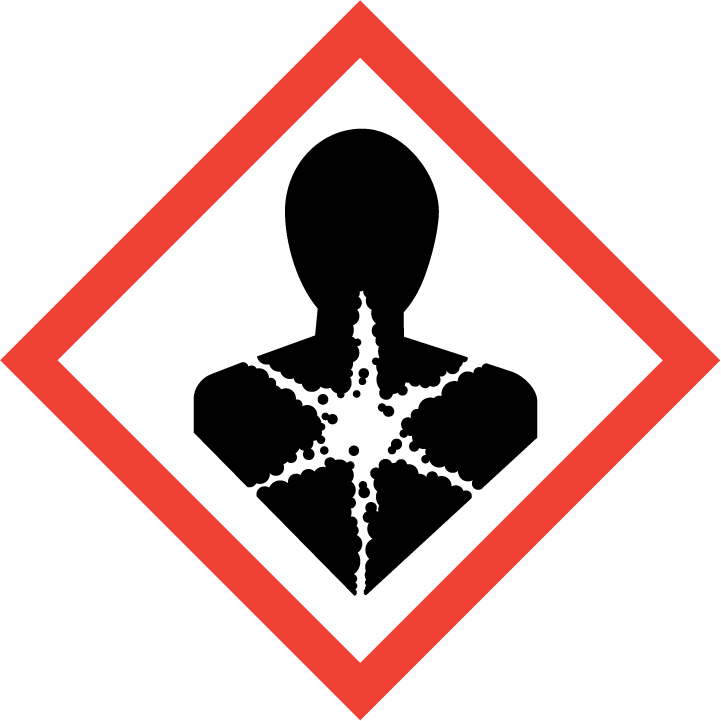

The quickest and easiest method of identifying a potential concern is the GHS (Global Harmonized System) pictograms (see diamond symbol above). If you see the chronic toxicity pictogram (diamond containing person with exploding chest), that means the product contains something that can cause long-term effects. That doesn’t necessarily mean a carcinogen, but it should prompt you to look closely at the Safety Data Sheet (SDS). You may need to take extraordinary measures to reduce personal exposure, or if that is unrealistic for your application, avoid the product altogether. The acute toxicity pictogram (diamond containing skull and cross-bones) means the product can have a short-term health impact. Again, check the SDS carefully if you see this symbol.
No Chemtronics contact cleaner contains toxic solvents like nPB, TCE, and Perc. While you still should pay attention to label warnings, SDS, and wear adequate personal protection equipment (PPE), the requirements will not be as over-the-top to stay within a safe range of exposure.
Are there environmental concerns with using electrical contact cleaners?
In the past, ozone depletion was a concern with contact cleaners containing chlorofluorocarbons (CFCs) like the Freon of old, and hydrochlorofluorocarbons (HCFCs) like AK-225. Since those solvents are no longer available on the commercial market in North America, concerns have turned to volatile organic compounds (VOCs), solvents that add to smog, or solvents with high global warming potential (GWP). Some state (e.g. CARB, the California Air Review Board), municipal, and even industry-specific regulations restrict the use of high VOC or high GWP materials.
To complicate things, VOC is defined and measured differently by various agencies. A contact cleaner might be considered low-VOC according to the standard EPA (Environmental Protection Agency) definition, but may be high according to CARB. If low-VOC is the goal, Chemtronics Pow-R-Wash™ Delta, Pow-R-Wash VZ, and Pow-R-Wash CZ are all great options to consider.
Chemtronics Pow-R-Wash™ Contact Cleaners
As we said before, there are no guarantees when the electricity is on, but the contact cleaners Chemtronics offers have a variety of dielectric breakdown strengths and they are rated on our website in terms of dielectric strength, cleaning strength and nonflammable properties.
Our products are non-ozone depleting making them safer for the environment. They remove grease and grime but are non-corrosive, and most are very safe for plastic components and rubber seals. Our DPL cleaner/lubricant will displace moisture and inhibit corrosion on electrical and electronic conductors and surfaces.
Chemtronics Pow-R-Wash™ contact cleaners, as an added benefit, have All-Way spray. This provides the option to turn the can as needed when spraying, so you are able to clean even confined or awkwardly spaced areas without spraying propellant instead of solvent. Generally, spraying propellant won’t do much more than super-chill the area you are spraying. But if you use a low-cost consumer-grade contact cleaner, such as those found in a hardware or auto parts stores, you need to be particularly careful. Many of those products use propellants like propane and butane – yes, the same material used by your gas grill or lighter.
Our technical assistance staff will be happy to discuss the products with you and answer any of our concerns or technical questions. Check out the Chemtronics contact cleaner selection guide [https://www.chemtronics.com/contact-cleaner-selection-guide].
For samples or technical help, email to info@itwcce.com or call 770-424-4888.
Source: Safe & Effective Electrical Maintenance with Aerosol Contact Cleaners

